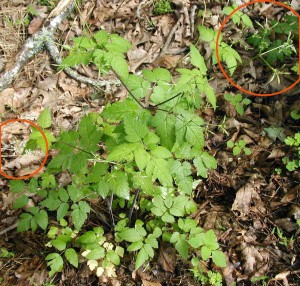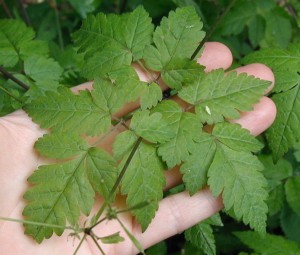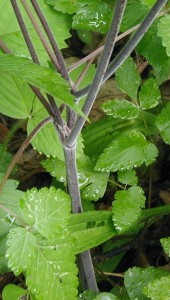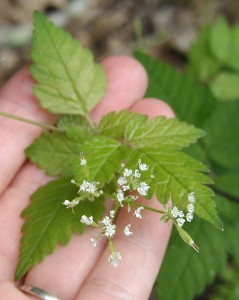The Parsley family, Umbelliferae or Apiaceae, encompasses dozens of useful plants with similar features, like flowers with five petals in umbels or umbrella-like clusters near the top of the plant. Leaves are toothed and divided, sometimes very finely. Examples are herbs and roots we commonly use in the kitchen, like parsley, dill, cilantro, fennel, and carrots.
Two native Parsley family members that can be found in the woodlands of the eastern U.S. are Sweet Cicely, Osmorhiza claytonii, and Anise Root, O. longistylis, which are very similar in appearance. Either of these woodland plants would look nice in a herb garden. The foliage is leafy and fern-like and the flowers dainty.
The main character differences are that Sweet Cicely is a softly hairy plant, while Anise Root is nearly smooth. Also, anise root has slightly longer stamen tips, hence the specific epithet longistylis.
The anise root plant photographed here was growing along a country road. It was still flowering near the end of May in Pennsylvania.

(Click on any photo to see a larger image.)
Take Caution: The leaves of Poison Hemlock, Conium maculatum, are similar in appearance. Do not ingest any part of any plant without a positive identification.
Sweet Cicely and Anise Root leaves are less highly divided, and potentially much smaller than, the leaves of poison hemlock.

Poison hemlock leaves have a bad smell when crushed, unlike the Osmorhiza which smell of anise or licorice. The sense of smell may be a poor indicator for some folks, so do not rely on this feature alone to distinguish poison hemlock from anise root.
Anise root stems are purple and smooth, while the stems of poison hemlock are spotted with purple.

Poison hemlock umbels are full of tiny flowers that make them look like several white spheres that may be held several feet high. Overall, poison hemlock plants are more substantial and grow taller. The umbels in Sweet Cicely and Anise Root are much more sparse with flowers than those of poison hemlock and they rise only 1-2 feet off the ground.

Peterson’s Edible Wild Plants Guide tells us that the roots and green fruits smell of anise and that they can be used for flavoring. I’m curious, does anyone use this woodland herb?
I have along my walk wild Anise , it comes back every year. I did not plant them . Probabley from birds carrying them here. I have dug the roots up and put in the freezer for the winter , just to chew on them because of the sweet taste.also have dried them to have them around to chew on. I’am wondering if any one knows it by Sweetroot?or what is Sweetroot?
I lived along Sweetroot Road when growing up, My paternal side was Owsago Indians,of Bedford Pa.They came up from the South in the middle 1800’s.I wonder if that was how Sweetroot Road got it’s name from the Indians naming it Sweetroot road.
Hi Rachel,
It’s very interesting that you’ve dug the roots for chewing. Did you just dig them up out of curiosity? At any rate I would think that anyone, be it Native American or early pioneer, could have named this plant “Sweetroot” because of its sweet smell. One source stated that the sweet smell is liberated once you put a shovel to the ground for digging the roots. Osmorhiza longistylis is also called longstyle sweetroot.
I’m curious…because you’ve dug up the plant did you spread the seeds or is there a nice big patch of Wild Anise available to you? It would be nice to see a large stand of this plant in the woods.
Thanks for taking the time to write. Enjoy your wild walks!
Thank you for the feed back on wild anise, the plant is spreading along my sidewalk and down over to a small garden below the walk , also I noticed on the other side of the house is a plant coming up in my herb garden. I think it got there of getting the seeds in my hair while pulling weeds near them and they dropped off to the ground.. also they stick to clothing, so ‘am sure they will spread easily. I went out and found a couple dozen seeds just now , will take them to the woods across the run (small water way ) and sow them. they spread fast. You can smell them when in bloom.
Reason for the digging them , they have a smell like Licorice (I love Licorice) which peaked my intrest, so being me ,I dug them up and chewed on them to find out what it was like to taste and liked chewing on the roots.
I use herbs and use to make soap for poison Ivy out of Jewel weed, (glass weed, touch-me-not).Good stuff to stop the itching and to kill the rash .
That’s cool! It’s so nice to find a plant that you like so much and one that sows easily. I’ll have to go back to the location where I found the single plant next spring to see if I can find more of the wild anise or maybe to capture a few seeds.
I never thought of making jewel weed soap, but it’s a good idea to have some around. It seems that it grows (around here anyway) where ever poison ivy does, so when I notice the jewel weed I know to look for PI if I haven’t spotted it already. If I think I’ve brushed up against some I rub some jewel weed all over the exposed skin.
Thanks for your story!
Best go for the seeds now if there is any left . I was lucky to get them this late,The seasons this year was early so very few seeds were on the dry stem although there are new plants growing already, next years crop ,Yea!
If you are intrested in making the soap I can write it down for you.
Happy seed hunting.
The seasons surely were advanced this year from whatever “normal” is. I plan to go seed hunting next year, but thanks for your tips!
Thanks for a great post about sweet cicely. It grows wild here in the Ozarks and I’ve picked and sniffed for a few years now and never got around to making a positive id on it. I love this native! Tasted it today and it’s very sweet, too. I’ll be making a blog post to spotlight it soon and will link to your page as one of the resources for my readers.
Thanks Madison! It’s nice to know that Sweet Cicely grows in the Ozarks.
Keep bloggin’ and connecting with nature!
hi nice site very helpful i live in north central Indiana and i just came across sweet cicely while mushroom hunting and it is literally everywhere behind my house wanted to make sure that’s what it was and reading here and seeing pictures it is and want to know what part of it is edible thank u
Thanks Josh!
Did you smell the anise? It’s nice, isn’t it?
I checked Peterson’s Edible Wild Plants to be sure. It states that the roots are edible in the spring and the green fruits in the summer. Both can be used as a seasoning or flavoring agent. The roots are edible at any time, it’s just that that’s the only part of the plant available in the spring and you’ll have to wait until summer for the seeds/fruits. Leaves are also edible and used for teas and seasoning in salads and such, but their scent won’t last so use them right away. Let us know about the green seed pods – when do they turn brown?
Did you find mushrooms on your hunt?
We have anise and sweet cicely growing in our oak forest in California! This year it’s all over, I’m taking the seeds to my herb garden!
Rachelle,
I saw a bunch of sweet anise root on my walk yesterday. I’ll have to remember to go back and get some seeds in a couple of months. Good idea!
I have a ton of wild anise root growing in my yard. It’s taking over everything! It’s hard to pull out and Roundup doesn’t kill it. The seeds are almost impossible to get out of my dog’s fur! I hate it! How can I get rid of it?
Hey Linda,
I’ve seen this plant on every walk and roadside venture I’ve had for the last two weeks. Evidently it is a common plant in Central PA. I guess those sturdy roots and all those seeds are doing the trick of keeping it coming back year after year. For this year at least, cut back the tops so new seeds don’t add to next years dilemma.
The best way to get rid of it is to get a shovel and start digging. If it’s hard to dig up all the roots, work on it a bit at a time. If you like anise or licorice, pop some of the roots in the freezer or dry them for a tasty treat. Thanks for the tip, Rachel!
Let us know how you make out. By the way doing lots of shoveling is a great way to work out. Does wonders on the core, arms and legs, so if you think of it like working on your body while you’re beautifying your landscape maybe that will help you really get into it. I wish you luck!
This is for Liz, aka wilde , Poison Ivy soap.
1 can of lye it has the direction’s on the can. What I did was pull enough of Jewel weed when about 1 foot tall or foot and a half ‘should Be ready about now before they get too big roots and all, clean off dirt and wash them good and shake the water off or pat them dry with a towel (glass weed) (touch -me not’s)Orange and yellow flowers,to fill a very large skillet or I guess a big pot, and Take your lard
( Must be Pig Lard) of the amount it says on the can (I think 5 pint’s) and bring it to a frying stage on low to cook the plant , can be cut up smaller to fit pan, if no large Skillet, fry them till they are fried good,
Let set to cool enough to put them in a large cloth and squeeze them till you get all the grease ( you will get some liquid from the plant ), when the lye water(I forget how much) is cool enough to pour in to the grease and stir, Do this early in the day as sometimes it doesn’t want to set up,so I stir and stir till I thought it was ready, I had a wooden box I poured it into. or have triangle Cake pan . If you know anybody that has made Home made soap , talk to them, Or try to Google it . as It sometimes hard, also be careful of the lye water as it can burn you. I think the lye water and the lard temperature has to be about near the same.
If you are in poison Ivy , take a bath with the soap as soon as possible,If you break out with poison Ivy , wet the soap .rub it on you where it is and let it dry ,don’t wipe it off, should keep the Itching down and then eventually kill it .
Hope it works out for you.
Rachel
Rachel,
Thanks so much for sharing your poison ivy soap recipe. Somebody reading might just benefit from it, but I hope we don’t need to use it!
Thanks again for the tips!
im going to try to boil the anise root and extract the tea product but want it to be naturally carbonated love to chew on the root myself
Robert –
Would love to hear about your experience and how you like the tea – how long to boil it? Did you harvest the plants already? Just curious if they’d be hard to find now that everything is moving into Autumn.
I use anise root to make a slow simmered chai made with almond milk. It gives it a wonderful flavor. I also use ginger root, cinnamon and cardamon in it. When visiting India I watched chai be brewed for an hour or even longer to get the most flavor. I tend to brew mine at a slow simmer for an hour.
How cool is that, Jeff! Do you buy the anise root locally and have you ever dug your own? We love to use the leaves of anise hyssop in teas for the licorice flavor.
Chai made with almond milk sounds fine too!
Thanks for your tips!
Hi, so interesting to read your experiences with Anise Root. I have what I think is Anise root–Osmorhiza longistylis. It certainly has long styles and a very loose flowering head. I read this article on both: https://hikersnotebook.blog/flora/other-plants/sweet-cicely-and-aniseroot if you can cut and paste it in your browser. Seems like Sweet Cicely is native to the Southern Appalacians, where I am located (Huntsville, Alabama). Really this is the Southern Cumberland Plateau, but nearly the same. The Sweet Cicely is growing in my front yard, and I just dug some and potted it. It does have a long white root, unless it hits a rock. If you soil is friable as ours is, it is easy to dig with a sharp shooter shovel. I love smelling it as I walk through, and I see it is good for many ailments, so I am going to try a tea. Thanks for all the information folks! Soos
Hi, so interesting to read your experiences with Anise Root. I have what I think is Anise root–Osmorhiza longistylis. It certainly has long styles and a very loose flowering head. I read this article on both: https://hikersnotebook.blog/flora/other-plants/sweet-cicely-and-aniseroot if you can cut and paste it in your browser. The Anise Root is growing in my front yard (Oak Hickory Forest), and I just dug some and potted it. It does have a long white root, unless it hits a rock. If you soil is friable as ours is, it is easy to dig with a sharp shooter shovel. I love smelling it as I walk through, and I see it is good for many ailments, so I am going to try a tea. Thanks for all the information folks!
Hey Soos!
This certainly is the time of year to see the anise root growing. We’ve got heaps about our mountain top growing nicely. I love the scent too!
Let us know how you make the tea…water not too hot? I feel some scents easily come and go quickly when the water is too hot. Enjoy!
Hi Soos!
Sweet cicely is around here too. Our ground is so tight as it’s clay and rocks. Lots of rocks. Difficult to dig obviously, but sometimes it’s worth the effort.
How did your potted cicely grow? Do let us know!